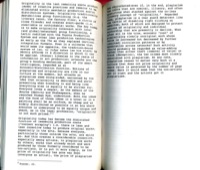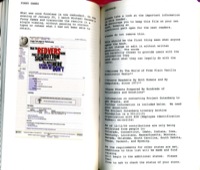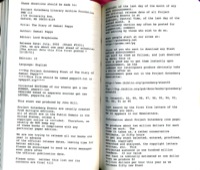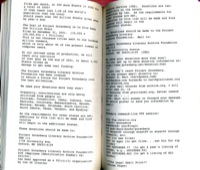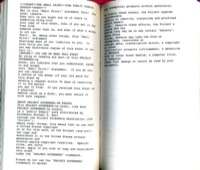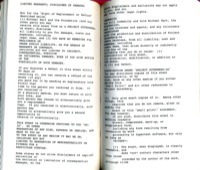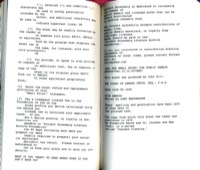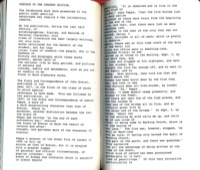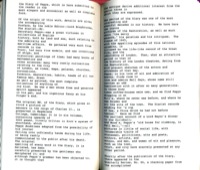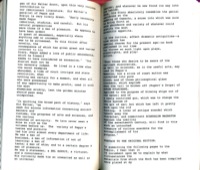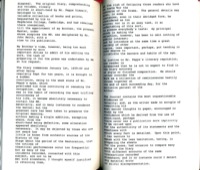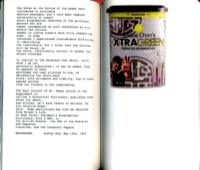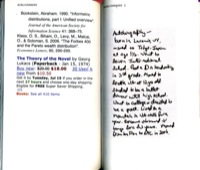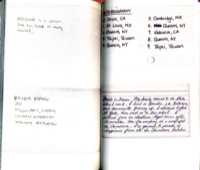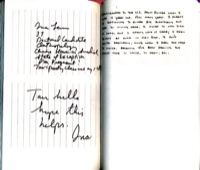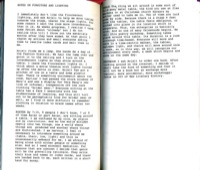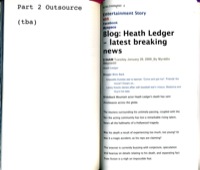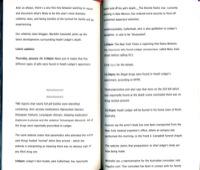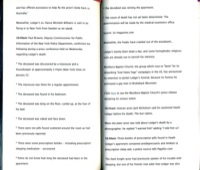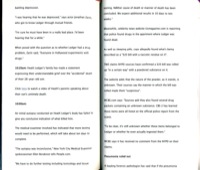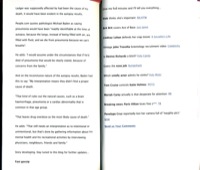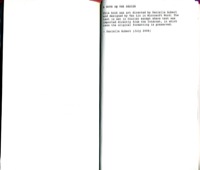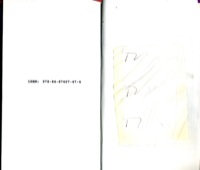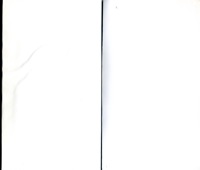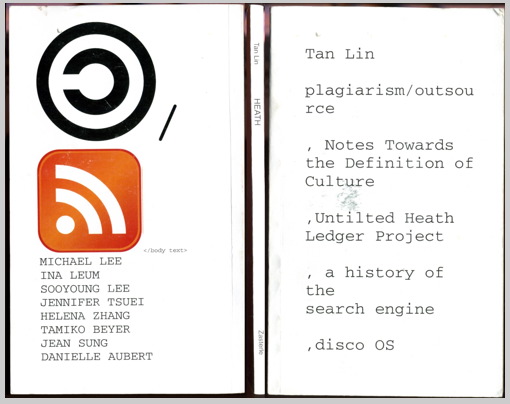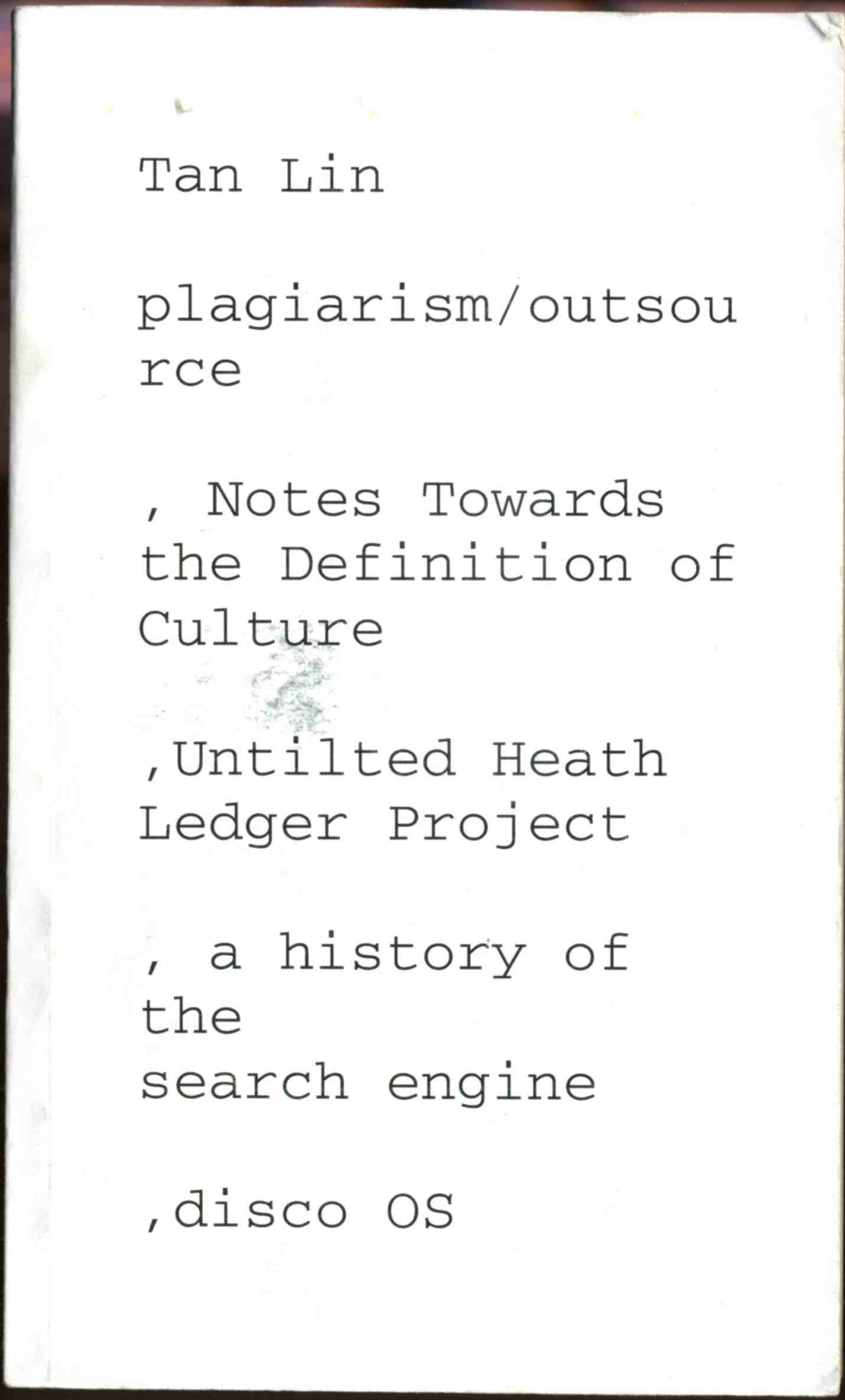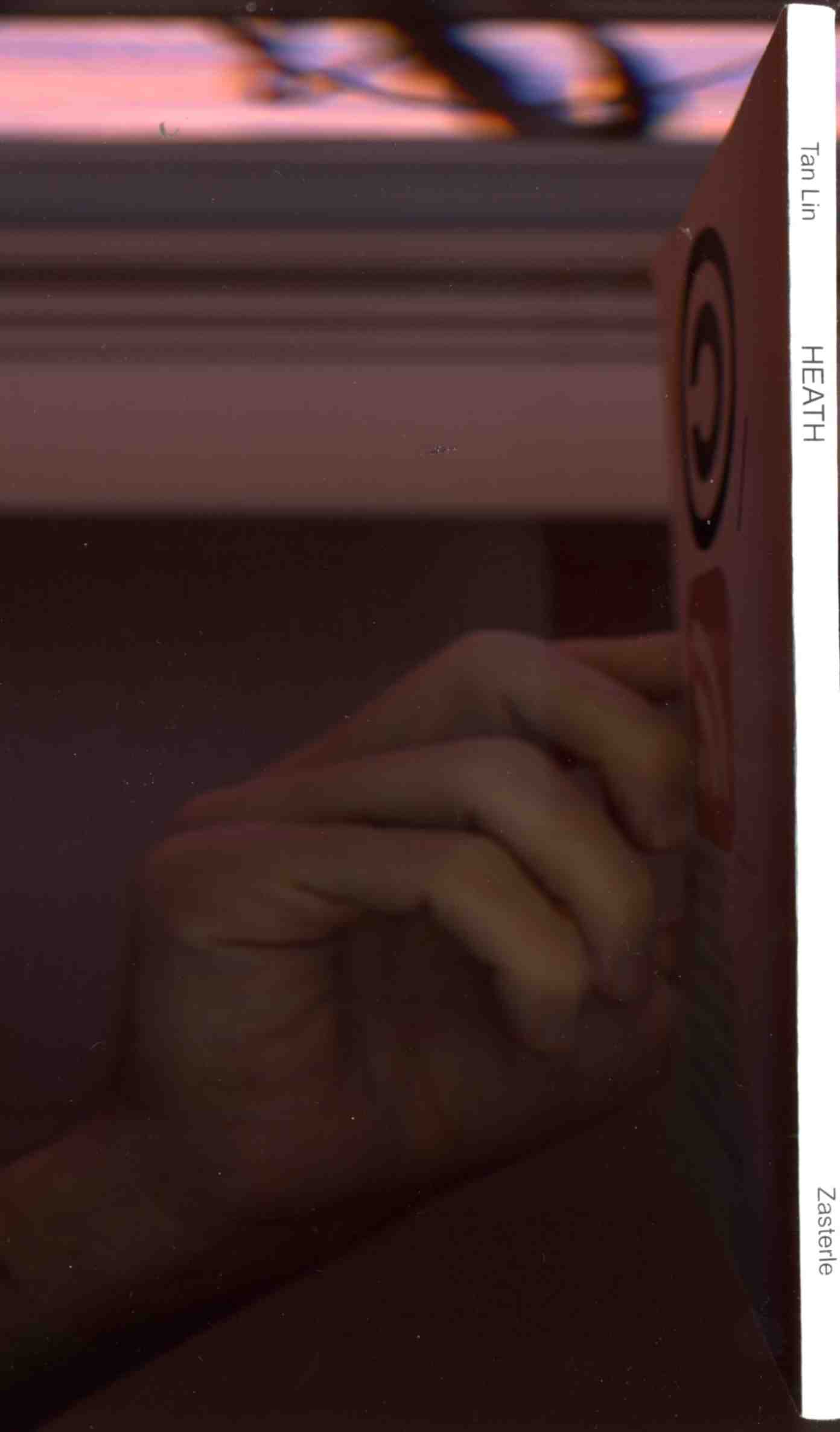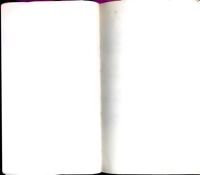
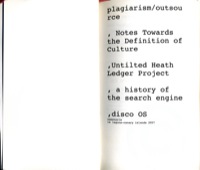
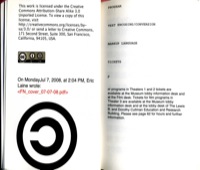
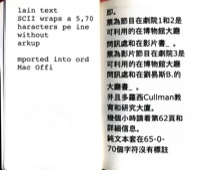
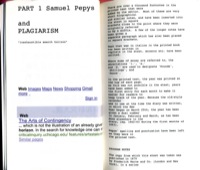
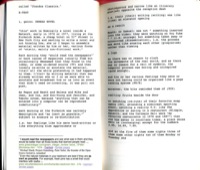
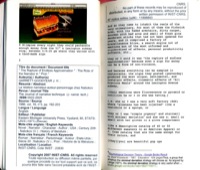
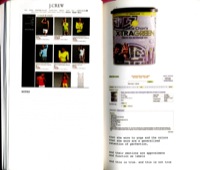
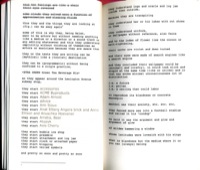
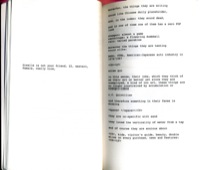
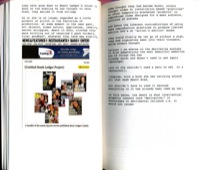
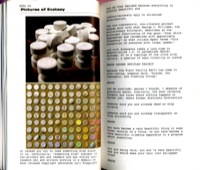
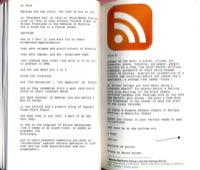
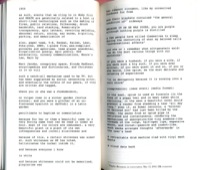
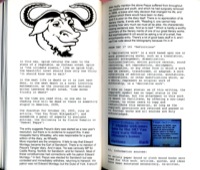
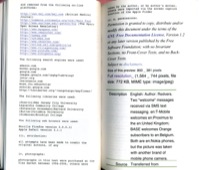
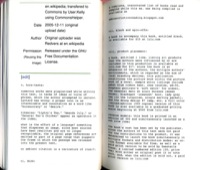
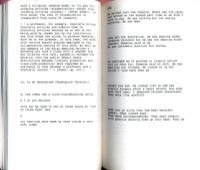
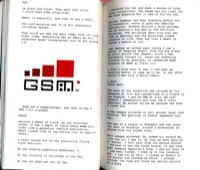
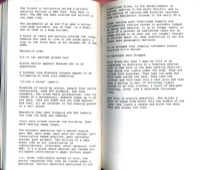
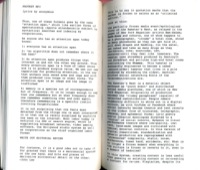
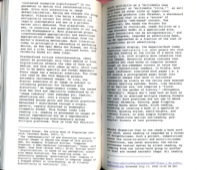
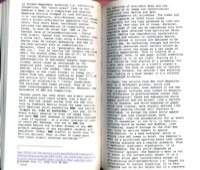
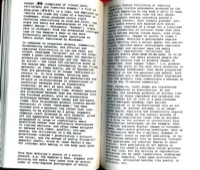
from what you are reading.
Tan Lin, Ambience is a Novel with a Logo
Autechre, Untilted (2005, mp3, 83mb, HL)
Donna Summer, Love to Love You Baby (1975, mp3, 50mb, DOS)
OCR (2010, RTF, 140kb)
Tan Lin, Heath (2007, PDF, 137mb, TL)
Tan Lin, Heath, ed. Danny Snelson (2010, PDF, 28mb, P/O)
Danny Snelson, Writing Sample Document PDF (2014, PDF, 2mb, DoC)
Abstract: This paper introduces the possibilities of tracing the networked associations enacted by a book called Heath by Tan Lin. As a test case, the writing explores Actor-Network-Theory, considering Heath both as an actor-network in ANT terms and a coterminous mode of sociological accounting.2 With a citation from John Law's "Notes on the Theory of the Actor-Network: Ordering, Strategy and Heterogeneity" printed within Heath, and remarks on Bruno Latour in interviews about the book, this approach seems both relevant and necessary.3 What Lin's poetics specifically shares with ANT is an emphasis on demystifying through detailed description, tactical citation, assemblage, and deployment through mediators and their relations, where every actor is a network. Without putting one method above the other, we will pursue the possibilities of writing sociology. This problematic will boil down to an essentially ethnomethodological question: how can literature perform sociology or what are the forms that a written sociology might take?
More directly, this paper traces the ways Heath translates diverse mediators from the digital event (the non-events) of Heath Ledger's death into an actor-network in material book format. These 'born-digital' actors include intellectual property disclaimers, popular advertisements, autobiographical details, ticket stubs, rejected articles, celebrity blogs, and RSS feeds. Thus the task of the critic—acting, in this instance, as a vigilant ANT—is to crunch the details of these manifold relations, as they are situated in Heath, to describe the network enacted through Lin's ambient citations and novelistic formulations. Lin admits that calling this work a "novel within a network" is, in a sense, an "extraordinary exaggeration," as there are few, if any, narratological markers of the novel genre.4 However, situating the book this way creates an anti-novel scenario able to investigate the genre from within its material, formal, and structural strategies. Where I have argued elsewhere that certain forms of Language writing in effect create structuralist readers, I am here concerned with how any reading of Heath necessarily assumes an actor-network approach.5
This paper consists of three parts. First, a sequence of metadata definitions of the subtitles presented on the cover of Heath, which are then utilized as citational tags throughout the paper.6 Second, an ANT exercise which carefully accounts for the first five spreads of Heath, both as a method to describe the mechanics of a 'novel within a network' and to argue for the necessity of actor-network-theory in this instance. And third, a more strategic and subjectively interpretive section which compares Lin's technique to actor-network writing in a tighter thematic units. The comparative usefulness of these three tactics is given attention throughout the paper and indeed each can only function in relation to the other. A controlled vocabulary will be established first and will feed parasitically on the rest of the paper. The detailed tracing of the first several spreads will point to the productive "inexhaustible search horizon" of actor-network tracing. And finally, the interpretive conclusion will build on the observations of the previous sections to compile an argument on the porous dimensions of the networked novel and the tenuous possibilities of writing (reading) networks.
Part 1: Cover: Tan Lin // plagiarism/outsource // , Notes Towards the Definition of Culture // ,Untilted Heath Ledger Project // , a history of the search engine // ,disco OS
Hidden among all these titles is the plain spinal core of the novel, the simple word Tan Lin uses to denote this unusual little book with all its confusing tags: HEATH.1 Quickly compiled, the book was written between May 8, 2007 (commissioned by Manuel Brito for his Zasterle Press) and July 14, 2008 (when the manuscript was delivered for design)—with the significant bulk of material composed on or after January 22, 2008 (the date of Heath Ledger's death).2 These 'time-stamps'—reminiscent of blog posting signatures, the additive markers of RSS realtime junkspace—are for Lin "a kind of parameter for the particular environment in question where both the figure and ground are in continual motion," and an entry into a form that can be, at the same time: "a loose, porous conduit: documentary, narrative, affective."7 Indeed these three modes: the 'factual recording' of real textual events, a concerted interrogation of narratological forms and assumptions, and the manifold reconstructions of feeling 'modes of subjectivity' characterize this 'novel within a network.'8
Chronicling the hotly contested and highly mediated death of Heath Ledger, Lin draws a remarkably heterogeneous array of digital texts and images into the material form of a book.9 Despite the remarkably inviting mode of 'relaxation' the narrative surface presents, it seems essential to begin again, simply and concretely, with the book as an object and the cover as an introduction to that object. We might start by noting haptic real-space data, not presentable in digital reproduction formats. A standard 6" by 9", perfect-bound book with soft matte card stock shell and a full color interior on what looks to be plain printer paper—just under a hundred pages in length, there is a fragility to the object—it's easily soiled: accidental bends and folds cause markings, incidental contacts leave traces. Even the ink on mine has worn in places from casual scratches. The ink is not glossy and the entire production looks almost as though it could be printed on a consumer printer, if not for the precision of the tight perfect-bound spine. It is an unassuming little book with the cover text written in an immediately recognizable, though slightly modified, courier font—the typographic design already marking the 'narrative voice' throughout the novel.10 The glitchy formatting irregularities of the cover, multiplied by a quick flip-through of the pages, gives the reader confused impressions of carelessness, haste, and untampered collage. Amplifying this unresolved unease, the grossly enlarged copyleft and RSS icons with their attendant pseudo-HTML code are uncannily remediated onto the page, larger than life and out of place. The clean san-serif spine, meanwhile, foreshadows the citational style of preexisting text: as though it is Zasterle's imposition of a title—Heath—on the spine, and the cover already forms a part of the writing of the book.
How then to account for the opening lines— the comma-separated values (CSV) on the front cover? In a recent email interview published in Galatea Resurrects, Lin writes:
Subtitles, especially vis a vis academic books, are marked by titular colonicity, whereas here commas function as list delimiters or maybe a series of programming commands... At any rate, Heath is kind of absent title for the work, or maybe a command: he was appended later compositionally,... he is central but not centrally localisable. Where is he? How does he define it or structure it, or make it congeal? How is Heath compiled?
...So I think it's useful to think of language here, but perhaps assembly languages, source codes, and/or compiling languages, etc.—something in a dynamic processing environment.11
How can a sequence of subtitles function as programming commands? What 'assembly languages' can process their operational syntax? How can this activity clue a reader into the compilation of the book? In the following series of definitions, I trace these operators as they recur throughout Lin's work, and specifically within Heath. Each, I argue, can be considered as a useful metadata value for processing the heterogeneous materials in the book. Thus Heath, the novel, executes these runtime commands through the "dynamic processing environment" of its epitext, activating a perverse brand of interpretive universal Turing machine.
Part 1.1: Metadata: Tan Lin: Claiming this top-of-the-page authorial primacy is a kind of tongue-in-cheek gesture for a book largely plagiarized, sampled, and distorted from various online sources. In addition to the more anonymous plagiarisms that comprise the book, this initial tag also stands in contrast to the eight names on the back cover. Probably unknown to the general reader, these are the students of Lin's poetry class at the Asian American Writer's Workshop, with the notable addition of the book's designer: the artist Danielle Aubert. In a section titled BIBLIOGRAPHY 2, these students submit hand-written index card autobiographies as outsourced bibliographic production. Placed on the back cover, the names appear as stamps of approval or competing authors: two-word blurbs from foreign authorities.
Nevertheless, the foregrounding of "Tan Lin" as a metadata tag is highly significant: every new book for Lin is a form of autobiography, or an exploration of the author's affective experience with textual culture.12 In a short book crossing photographic essay with personal memoir, Ambience is a Novel with a Logo (Katalanché, 2007), Lin writes, "the structure of a feeling, like the xerox of a photograph, should be opaque or very realistic in order to make the characters in it more imaginary."13 Thus, "craft would be replaced with the handicrafts and the utensils of writing." And, "recipes, obituaries, receipts, tickets, text messages, itineraries, legal briefs, and disclaimers would constitute various surface entrances." This radical artifice, Lin argues, is necessary such that "emotion and empathy would be built into the novel and not produced artificially by being inserted into the lives of its characters." As Lin's idiosyncratic memoir form persists throughout Heath, the reader can best trace the moods of lived experience, even when the translations are faked. In an introduction to Lin's artificial memoir Ambient Sylistics for the Boston Review, Charles Bernstein focusses on this style as a means to "critique a number of the underlying assumptions of 'innovative' poetry, exploring ways to make poetry more readable and, as he puts it, more relaxing."14 Similarly, Brian Kim Stefans, in a review of Blipsoak01, notes Lin's desire to "shake off the trappings of the avant-garde—linguistic difficulty, the suspicion of beauty, all manners of formal estrangement."15
The phrase "Tan Lin" recurs only once more throughout the text—as a concluding note on the book design written by Danielle Aubert, "This book was art directed by Danielle Aubert and designed by Tan Lin in Microsoft Word." Aubert explains this relationship online—her 'design' of the book simply affirms the unmodified Word document importation of online image and text done by Lin.16 This conceptual gesture common in found poetry or conceptual art comprises the outsourcing of the design. Similarly, the 'outsourced' autobiographies in the bibliography section of Heath are nothing more than classroom assignments given by Lin to his students, which are presumably then scanned into jpgs for publication by Lin himself. These complicated feedback loops from author to agent and back again interrogate the author function active in all outsourcing and plagiarism. [TL]
plagiarism/outsource: As plagiarism/outsource falls directly below Lin's name on the cover, this is often assumed to be the title of the book. It might seem appropriate as one of the work's central arguments is the delineation between these two forms of cultural production. The two terms are in fact the respective titles to the two parts of the book, with the vast majority of the book occupying the first part on plagiarism. This dual tag is strategically engineered to bypass the shock-rhetoric of avant-garde theft17—instead acknowledging the textual conditions that continually produce massive amounts of everyday text: from the outsourcing of the author in judiciary statements, museum protocol, associated news circulation, in blogs and on social networking sites: "appropriation per se is no longer shocking—it is just part of our reading cultural environment where information is exchanged continually and for the most part freely."18 More radically, in "Disco as Operating System," the forensic materiality of plagiarism can be traced down to the various media through which these texts are generated: "most writing is automated and invisible, an empty form of surface decoration where 'writing' is the instantiation of a software code being transferred from one location to another in an act of self-plagiarization."19 In Heath, Lin builds on these conclusions to reexamine the situation of textual labor (from Samuel Pepys to Project Gutenberg to Tan Lin) in a reading system driven by the search engine. The distribution of real and cultural capital through free information exchange and online circulation is vexed, to say the least. "At any rate, plagiarism ceases to matter very much in a culture that does not prize originality and where value is generated by the number of page views."20
As political readers, understanding the ways these systems commodify attention spans as information generators in online environments presents an increasingly important prerogative. In Seven Controlled Vocabularies and Obituary 2004, Lin notes "Subjective events like emotions are easy to control and standardize, as the t.v. in the board room reveals."3 Under the conditions of generalized appropriation and confused authorship, Lin's strategy of transparent plagiarism clears a space for an individuated attention span more in control of its affective labors. "So I would generally say that the 'work' of Heath is a 'mode of subjectivity' or 'subjective space' and it is, as I said earlier, a process of blind labor (someone is clearly laboring in Heath) whose product is attention, where attention produces the objects that interest us."21 Starting from the assumption that this process generates page views, advertising revenue, and ultimately surplus value, the novelist opens a 'mode of subjectivity' by claiming these reading experiences as one's own and thereby reclaiming the objects produced by attention theft. "Both plagiarism proper (unacknowledged appropriation) and sanctioned appropriation redeem the individual from the market's branding mechanisms."22
The networked kidnapping (plagiarism, derived from the Latin plagium [kidnapping], from plaga [snare, net], from the base plak [to weave]) claimed as a feature of unending RSS feeds and proliferating links, where every object is updated with a new time-stamp and authorial recounting, is a central component of the massive redundancy inherent to functional information networks. Lin writes, "all plagiarism is part of an operating system," the post-medium instantiation of one software code to another is the operating basis for all networked activity.23 Indeed the central means of reading and writing online, like the read-write heads of hard drive memory mechanisms, are intimately bound to diminished author functions. From the covers, we can set up the analogy plagiarism is to outsource as copyleft is to RSS feed. As Richard Posner—accurately cited in Heath—reminds us, plagiarism has little to do with the violation of copyright, and everything to do with a false claim of authorship. But who is claiming authorship of the text reproduced in Heath? On what grounds? As the unchanged formatting and mixed citation clearly indicate that Lin strictly 'authors' little of the writing, is the work still plagiarist at all? Uninterested in the originality/creativity or intellectual property debates that characterize much of the discourse around this scenario, Heath questions the mechanics of authorship itself. [P/O]
, Notes Towards the Definition of Culture: Richard Hoggart follows his 'rough definition' of the working classes in The Uses of Literacy with an unattributed citation from Eliot's The Wasteland: "What are the roots that clutch...?" Including the question mark after the ellipses, this quotation slyly includes the omitted "what branches grow // Out of this stony rubbish?" (Ouch.) While Hoggart elsewhere makes use of this elitist Eliot as a kind of paragon of high culture ("an unspoken regret that, though we are now a literate people, not everyone reads, say, T. S. Eliot")24 he nowhere mentions the great founding work of cultural studies that Lin is here plagiarizing as his title, Eliot's 1948 Notes Towards the Definition of Culture. The oft cited passage from Eliot's treatise defines culture as that which,
includes all the characteristic activities and interests of a people: Derby Day, Henley Regatta, Cowes, the 12th of August, a cup final, the dog races, the pin table, the dart board, Wensleydale cheese, boiled cabbage cut into sections, beetroot in vinegar, 19th-century Gothic churches and the music of Elgar. The reader can make his own list.
While this passage has been extensively linked to the development of a cultural studies concerning the 'whole way of life' expanded by Raymond Williams, its composition of predominately non-humans would further delight the actor-network theorist. Lin, however, who often works with similarly extensive and incongruous lists (as Heath itself may seem an entirely arbitrary, that is to say, formally subjective, online listing) might be most interested in the final line commanding the reader's autonomy. In Disco as Operating System, Lin remarks on the role of notes in Duchamp's Large Glass:
Conceived of as a series of delays, one of which was the notes, Duchamp's completed work was not merely a mimetic translation of a content it transmitted (i.e., a function of efficient economic exchange); rather, it was the mechanical transmission itself, a process made visible by delay... The glass in The Bride Stripped Bare by Her Bachelors, Even is a computational device. It "translates," in a process subject to both medium- and time-delay, a "media object" sandwiched (like a commodity) between photograph and painting.25
Like Latour and Law, Lin figures this puntualised accumulation of a network of notes as a 'translation' of a series of delays into an actor as computational device. The emphasis on error, original formatting, unfinished (unpolished) writing, and a sense of the incomplete characterize the temporal qualities of the book: a meditation on ephemerality, presence, and forgetting. [DoC]
,Untilted Heath Ledger Project: The accumulation of these metadata tags and the resistant forms of writing featured in the book suggest the necessity of forgoing the title. Straddling art and literary contexts, this tag resembles the more common "untitled" of a painting. Aside from isolating the book as more of an art object, material artifact, or assemblage than as a unified narrative, it also opens the possibility of other incarnations of the project: including expanded networks of artistic production around the themes of the novel and Heath Ledger in particular. As Thomas Fink notes, Heath suspiciously draws attention to an absent 'ledger,' the non-event of a functionless accounting, an inventory of imaginary affects.26
Closer inspection, however, reveals more creative misreading as the tag is not 'Untitled' but 'Untilted.' While this detail is overlooked by most readers, (a simple google search reveals twice as many hits for "Untitled Heath Ledger Project") or assumed to be an insignificant accident, the minute swerve of this choice reveals scores about the project. "(Untitled Heath Ledger Project)" was the title of Chris Norris's nuanced New York Times article following Ledger's death, stressing the frenzied mediation, contradictory coverage, and conflicting statements in a "masterfully vague" character sketch of the star.27 While Lin's Heath quite literally plagiarizes this newspaper story (and even reproduces an unattributed image of the fourth online segment), the cover glitch (also reproduced on the title page and by Lin in all interviews) 'Untilted' opens a new dimension.
Untilted is the name of a 2005 album by IDM glitch stars Authechre.28 Released in a haze of forgery, a reverse-plagiarized version of the album created by the hoax artist known as Flourescent Grey, infamously circulated simultaneously with the album's promotional leak.29 In an early exploitation of the confusion and absence of legitimating forces in file sharing networks, this play with the networked author function is not unlike that ventured in Heath. Lin's previous book of poetry, Blipsoak01 (Atelos, 2003), is a sort of mimetic tribute to glitch hop IDM, which in turn, can be figured as the contemporary analogue to the disco networks of the 70s. In the introduction to Blipsoak01 Lin writes that such a mistake "is the product of various mediums which linger and sooth, including disco, optical illusions, IDM, late night television, photography, and the various 'non-designs' of P. Starck and his disciples."30 One example of the many irregularities, errors, glitches in Heath, 'Untilted' demonstrates Lin's belief that:
Everyone likes to // wait, though not in any particular order, for a mistake or an accident. [That is why] the left hand side of the page remains temporally uninteresting, and why the surface of the ambient poem you are gazing towards is highly distracting, filled with imprecisions, typos and forms of the hypnotic, which function backwards, just as boredom itself does.31 [HL]
, a history of the search engine: Not "the history," but "a history." Heath collects a singular history of the search engine in use by a writer as DJ over the course of a few months. In a section on 'information sources' Lin reveals "no solely paper bound or cloth bound books were used for this work. articles, quotes, and ideas have been annotated extensively, re-written, and removed from the following online platforms: ... The following search engines [libraries and web browsers] were used: ... " Like his experimental blog AMBIENT FICTION READING SYSTEM 01, which attempts (and fails) to list everything Lin read for a year, this 'history' is structurally similar to the personal diary maintained by Samuel Pepys.4 As the preface to Pepy's Diary, reproduced in Heath, notes: "this class of literature has been largely enriched, not only with works calculated for the benefit of the student, but for that larger class of readers—the people, who in the byeways of History and Biography which these works present, gather much of the national life at many periods, and pictures of manners and customs, habits and amusements, such as are not so readily to be found in more elaborate works."32
Another recurrent search engine experiment in Lin's work investigates the redundancy of massively index writing—how many 'original' two- or three-word sequences cannot be discovered elsewhere with a search engine? Ambience is a Novel with a Logo, like Heath, features a subtitle system comprised of concordance citations in the format of Google search entries which seem to correspond to passages from the body of the text. Often these subtitles appear to have little to do with the texts above them, pointing instead to the primary redundancy of the formulation while offering secondary entries into diverse domains which regularly carry uncanny applicability.5 This ambiguous authorial activity radically interrogates Gerard Genette's paratext, the 'undefined zone' or 'threshold' of a text, "without any hard and fast boundary on either the inward side (turned toward the text) or the outward side (turned toward the world's discourse about the text)" which is nevertheless "more or less legitimated by the author."6 Emphasizing the softness of the paratextual threshold, Lin's most recent work "SOFT INDEX (OF repeating PLACES, PEOPLE, AND WORKS)," appended to the end of the fall 2009 boundary 2, intermingles anecdotal notes with high theory, poets, novelists, family members ("Ahn (daughter),"), passing interests, websites, pop references, and literary terms—very few of which can be located on the pages of the journal itself.33 In playful reference to nonexistent pages, the "SOFT INDEX" simultaneously pushes the reader into the journal (which is itself outed as plagiarist "paraphrased or slightly reworded material" and outsourced as an apparatus for the index34) and back out into the Internet to trace sources and find meanings as each networked item presents a riddle in search of the author.35 Ultimately, these manifold flows into the hors-texte punctualise only on the "dispersed awareness" or "mode of subjectivity" of the actor-author-network. As Alexander Galloway, in statements on protocol and counter-protocological practice, remarks: "a new exploit is necessary, one that is as asymmetrical in relationship to distributed networks as the distributed network was to the power centers of modernity."36 [SE]
,disco OS: Like 'Untilted', 'disco OS' creatively misrenders Disk Operation System or DOS, translating the computational interface between users, applications and hardware into the 'post-medium' networks of disco. A more perverse reading could interpret the aural neologism echoing between 'disk' and 'co' as the meeting of hardware and corporate branding device. Indeed, in "Versus Seamlessness," Jennifer Scappettone offers an extended commentary on the 'pseudocomplicity' of Lin's ambient writing, taken on its surface in a rhetoric of ease and relaxation, in the seamlessly neutralizing 'junkspace' of late capitalism.7 The actual existence of an experimental Disco Operating System "designed to make it easier to extend 'commodity' operating systems to multiprocessor machines" made by the Computer Systems Laboratory group at Stanford in the nineties, would seem to validate this interpretation.37 Turning back, we might note another sly plagiarist reference to an obscure electronica DJ recording under the moniker 'Disco OS' since 1996—producing incredibly relaxing sampled sounds, maintaining an active myspace page, and recording on several smaller labels.38
Such a programming language was once called literature (we have chosen to call it art history), though disco, of course, is not a literature at all; it merely simulates the effects of literature (as empty brand) with the uncanny precision of our era's version of a lullaby: the remix.39
In his illuminating essay "Disco as Operating System, Part One," Lin systematizes his post-medium notion of disco as the "production and distribution practices associated with 'social media' ... where the line between singing and acting, listening and participating, between a celebrity and what Warhol called a 'nobody,' and between an individual and a network were being dissolved in an era marked by flexible accumulation and the transformation of culture into a fluid species of capital."40 This theory-heavy concept is built on Fredrick Jameson's writings on late capitalism's cultural commoditization, Rosalind Krauss's arguments on the dissolution of the medium in art, Lev Manovich's theories of software and remix in digital environments, and Friedrich Kittler's work on inscription media and discourse analysis in Discourse Networks 1800-1900, and further includes the artistic practices of Eliot, Duchamp, McLuhan, Warhol and Koolhaas to name a few. "Or to put it more simply, disco is an operating system that sits on top of a database (previously recorded musics), which is in turn accessed by a DJ, who serves as a GUI for those on the floor."41 If the reader is "on the floor" in this scenario, then the author resembles the DJ-GUI filtering critical-aesthetic theory through quotidian textual samples from the collective database of the Internet. [DOS]
Part 2: A Horizon of the Unpublishable: After the metadata introduction of the cover and title page, the book opens a miniature forum on the hotly contested issues of intellectual property and copyright in the distribution of digital formats. Playing with the "zasterle / la laguna-canary island 2007" official
publication date, the following page (where trusted copyright and edition information is usually found) states:
On
MondayJul 7, 2008, at 2:04 PM, Eric
Laine
wrote:
<FN_cover_07-07-08.pdf>
just below a Creative Commons Share Alike 3.0 disclaimer-icon and above a ridiculously large 'copyleft' symbol.42 [P/O] The first in a series of 'error-prone' phrases in the book, it points to an impossible (a year after the Spanish ISBN had been registered by Zasterle Press) and impossibly precise (down to the minute) moment of publication. Eric Laine, director of bipolart and presumably the designer of some final aspect of the cover—still a week before the manuscript was delivered for design—here momentarily replaces Lin as the 'author' or disputed CC/copyleft holder of the publication.43 Foregrounding the digital tools used in the text's generation, the reference to ".pdf" in mock-HTML on this opening page sets the format-dependent processing that continues throughout the novel. [P/O]
While the ISBN is typically found on this page, the cataloging number rather concludes this novel, occupying the entire final page in the interior of the book. [SE] Serving as a kind of soft index registering the book's circulation rather than the distribution of topics within the novel, the ISBN—written before the book itself—highlights the temporal paradoxes of material publication. Lin is fond of quoting Marshall McLuhan's paraphrase of Lamartine's 1831 statement on newspapers: "McLuhan was right; 'the book ... arrives too late.' Events (like the politics which plagiarize them) should disappear like anecdotes into a novel without ever becoming events."44 Where McLuhan was quick to recognize the feedback loop of book and newspaper media, elaborating on the 'mosaic form' of the novel developed under the cultural logic of newsprint, Lin extends Lamartine's prophetic remarks into the robust ecology of digital media, where the anecdote remains a 'horizon of the unpublishable.'45 Temporally obsolete, a book highlighting the bibliographic details of its publication history absorbs its format back into the writing, and heightens the reader's sense of the disappearance of the event through the text. [TL]
Part 2.1: PROGRAM: On the recto facing this bibliographic data, the book introduces the complexities of materializing text under the ambiguous title "PROGRAM." [DOS]. Accompanied by "TEXT ENCODING/CONVERSION," this 'program' seems to refer to software translation instructions. Or, followed by "MARKUP LANGUAGE", it coordinates graphic design. Then again, by "TICKETS", it materializes admission to an unnamed event. Finally, "F," the last in this set, designates this whole process of compilation in its reference to 'F,' a robust programming language developed to operate Fortran. [SE] Short for The IBM Mathematical Formula Translating System,it was one of the earliest and most widespread assembly language compilers. Lisa Gitelman has written on the ontological problems of defining the "varied materiality of electronic texts" through specific example of the "mysterious (that is, illegible) patterns of holes" in the paper keypunch 'tickets' employed by Fortran and by other early computing systems.46 These programming languages, introducing the actors cited in Heath, are thus radically variable: "they can be [programmatic] without being confined to a single practice." [TL] As a prelude to the novel, Lin compiles this short set of conflicting systems of production—digital encoding, software markup, material printing, and assembly language formula translation—to ask: where does one locate the writing of Heath? Hoping to trace these heterogeneous processes, how do we get with the program?
Further complicating this programmatic assemblage, "F" feeds into the next paragraph as "F/or programs in Theaters 1 and 2 tickets are available..." a paragraph lifted from a MoMA member's brochure, directing the reader to the appropriate theater for a film program. [HL] Thus, the real-space instructional code to navigate a museum is translated into a history of computation, an investigation of material text, and an allegory for compiling the novel. Building on these connections, the reader later discovers a narrator receives an SMS while in one of these MoMA theaters:
The news of his condition was relayed by his masseuse at 3:31 and transmitted to a friend in Los Angeles. I got an SMS at 4:52. We left theatre 1 immediately and took the E train downtown. My mother called me because she knew I loved him, [TL]
Following the narrative of Ledger's death, this note situates SMS reception within the operating system enacted by the preceding programmatic extensions of the MoMA theater brochure. "Everything was an empty as shit corporate space transplanted into an art museum i.e // GSMTM (image) // . MoMA was a doppelganger, and then he was a GSM 7-bit alphabet // HEATH." [DoC] This sort of bewilderingly multifaceted depiction of SMS is dispersed throughout the novel: by turns affective ("Like SMS, it's a place where desires are ranked and collapsed"), economic ("Today, SMS traffic is worth over 70 Billion dollars"), technical ("SMS is the fastest form of telecommunications"), political ("Most labor today is mediated via SMS or search engine"), formal ("The configuration was 70 16-bit characters including spaces"), and mimetic. [SE] Similarly, the program / ticket / theatre 1 mise-en-abyme opening the novel replicates itself throughout the text as actors, citations, search entries, and other ambient writings are brought face to face with the conflicting processes of creation, reproduction and distribution that characterize contemporary media.
Further, the short MoMA note is reprised on the following page, hilariously rendered by Google translate into large-print Chinese (a family language Lin doesn't speak). "Cullman"—the one word that isn't recognized by the translation algorithm—is perhaps a doppelganger standing in for the author, actively gleaning text while selectively absent from a variety of processes outside writerly control. [TL]
So here the book multiplies into a different what I'm not sure, distribution format, text, social event? Not even sure how to describe it. I think what is interesting is what sanctions or makes possible (it's not an author in any conventional sense) all this material: quasi-legal discussions, legal documents, class room paraphrases, movie posters, trailers, my Netflix reviews, a member's brochure at MoMA describing where to buy tickets, my teaching at UVA (where I met Charles Bernstein) and NJCU, a publishing house in the Canary Islands, and even Google's translation application (a service of some sort, and I really want to know who uses this service and why, and what are the economic bases for such a "free" service?) which renders or authors the ticketing information into Chinese—why is it all together in the first place? What exactly is this reading environment or social system that would link all these things together?47
Following the actor-network call to deploy 'matters of concern,' Heath thus presents a sociology of associations mobilized to "feed off uncertainties," introducing multiple agents "with their mode of fabrication and their stabilizing mechanisms clearly visible."48 The "reading environment or social system that would link all these things together" is precisely the book which enacts a heterogeneous network between these previously (seemingly) disparate texts. [DOS] Heath, in bringing "it all together in the first place" both creates these relations and sets them in a sequential conversation by programmatically delimiting the array through the fixity of the printed page. [DoC]
While the eye quickly gazes over the Chinese characters, the verso's facing text forces the reader to slow down. "lain text / SCII wraps a 5,70 / haracters pe ine / without / arkup // mported into ord / Mac Offi" [DOS] If the previous spreads attend to the materiality of the book, this dense network of glitches, errors or blips, focusses the reader on the materiality of the words, typographically and semantically. After Lin's tract on data loss in Blikpsoak01, we know this noisy transmission is meant to be "looked at one word and then one letter at a time."49 Despite Lin's signal jamming, the phrase is easy to parse: the standardized 70 character soft wrap function of Microsoft Word arbitrarily mediates the hard line breaks of unmodified online text, creating the strangely poetic and entirely generic form which characterizes much of this book. ASCII, the standard number-to-letter encoding for information exchange, locates the letters as digital objects, while Mac Office locates Lin's workspace in a branded computing environment. [TL] Mixing conceptual transparency with textual artifice, Lin presents a rigorous objectivity through a format dominated by lies. Lin answers Latour's most pressing uncertainty by preserving the integrity of source text markup scenarios. Rather than 'scrubbing' or reformatting the text to fit the margins of a new Word document, he demonstrates how "the event of the social can be extended all the way to the event of the reading through the medium of the text."50
Part 2.3: Inexhaustible Search Horizon: The following page opens the larger of the two parts comprising Heath. "Samuel Pepys and Plagiarism" constitutes 90% of the book before being concluded by "Outsource (tba)." [P/O] The subtitle—"inexhaustible search horizon"—is footnoted by a google search entry and an attendant bevy of defunctionalized Google inter-site links, comfortably offering the reader the familiar options to "Sign in" or go "Shopping." [SE] The snippet footnote links to an article by Elena Esposito on transmission and the development of the printing press as it pertains to sociological systems theory for the special issue of Critical Inquiry on the "Arts of Transmission." Defining the arts of transmission as "the whole of the procedures that circulate, record, and organize knowledge," Esposito expands on Niklas Luhmann's formula "medium/form" as a means "to have available conceptual instruments that allow us to distinguish and at the same time to connect the question of transmission (media) with its semantic presuppositions (forms), without giving priority to either aspect."8 The openly plagiarist fidelity to digital formats (and their presuppositions) in Heath demands the reader recognize the connection of the printed book to its once-digital text while simultaneously highlighting the variously distinct processes of mediation. This functional differentiation articulates a disjunction similar to "sociological research [as it] is conveyed through oral or written communication, which is printed or mediated in various ways. To study the required conditions and the ties imposed by media means at the same time to investigate the conditions and ties of the very communication through which one studies them, which remains subject to them even if it allows their functioning."51 Negotiating the paradoxes of a media study that is itself mediated by the writing is then the 'art of contingency' that Lin underscores in this opening page. In the passage following the concordance entry for "inexhaustible search horizon," Esposito describes how the advent of print allows one to "move on both levels; one can investigate nature with a previously unknown freedom, but one can also consult, confront, and combine books. It is not only the single text that is decomposed and combined in different forms; the relations among texts, or the general horizon of communication, also become possible objects of decomposition and recombination."52 This movement perfectly describes the book as disco operating system: staging combinations, decompositions and recombinations with attention to the complicit relationship of medium and form, Heath writes a sociology (of textual platforms) from within the mediating systems themselves. [P/O] As Latour reminds us, "the task is to deploy actors as networks of mediations."53
Part 3: Translation: After having worked through the cover program and the "paratext" opening the novel, we can turn to the relations between Heath and ANT with a sense of how the 'novel within a network' can operate. Turning first to Lin's citation of John Law's introductory "Notes on the Theory of the Actor-Network: Ordering, Strategy and Heterogeneity" in the PROTEST MP3 sub-section of Heath: "For instance, it is a good idea not to take it for granted that there is a macrosocial system on the one hand, and bits and pieces of derivative microsocial detail on the other."54 [DoC] Opening an embedded essay (on the networked non-events of Dash Snow's Hamster Nest), it is itself an emended reaction/redaction of a New York Times article. Through the citation, Lin expands the 'good idea' to include the detailed bibliographic histories of the image-text 'bits and pieces' along with the sequential narrative strains that comprise the novel.55 Correspondingly, we expand the citation to consider the rest of Law's paper through this portal into Heath. In its concise introductory form, "Notes on the Theory of the Actor-Network" provides an ideal stage for comparing the stated aims of ANT with the strategies of deployment featured in Heath. We find the 'bits and pieces' cited above in fact direct us to the core of the actor-network approach:
Another way of saying this is to note that the bits and pieces assembled pro tem into an order are constantly liable to break down, or make off on their own. Thus analysis of ordering struggle is central to actor-network theory. The object is to explore and describe local processes of patterning, social orchestration, ordering and resistance. In short, it is to explore the process that is often called translation which generates ordering effects such as devices, agents, institutions, or organisations. So "translation" is a verb which implies transformation and the possibility of equivalence, the possibility that one thing (for example an actor) may stand for another (for instance a network).
This, then, is the core of the actor-network approach: a concern with how actors and organisations mobilise, juxtapose and hold together the bits and pieces out of which they are composed; how they are sometimes able to prevent those bits and pieces from following their own inclinations and making off; and how they manage, as a result, to conceal for a time the process of translation itself and so turn a network from a heterogeneous set of bits and pieces each with its own inclinations, into something that passes as a punctualised actor.56
Reading this, briefly, as a description of the 'strategy of organization' in Heath, we can first argue that the ordering process of Lin's compilation demonstrated concern with these "processes of translation," generating the possibility of equivalence among sources (actors or authors) in the novel. Callon's four moments in the process of translation apply especially well to the novel within a network.57 Further, in light of this passage, we can ask to what extent Heath itself "passes as a punctualised actor." According to Law, a punctualised actor is simply an assemblage that functions so seamlessly as to mask the network of interactions that compose its coherence as social actor. Law gives the example of an automobile. Until a part breaks down, or depunctualises, the user forgets that the vehicle is not simply a transportation device, but an elaborate mechanism built of many interworking pieces. While the kind of dissected tracing that we have employed here may dissuade the reader against claims to Heath's punctualisation, this is precisely the state to which Lin gears his writing:
...the writing and in particular the nonwriting of poetry and art, where lyricism, subjectivity, and personal expressiveness might be reduced to blips in an ambient sound track, where historical markers (of cultural products) could be erased, and where nonreading, relaxation, and boredom could be the essential components of a text. Poetry—and here one means all forms of cultural production—should aspire not to the condition of the book but to the condition of variable moods, like relaxation and yoga and disco... they might resemble a pattern uninteresting and enervating in its depths but relaxing on its surface.58
Thus, it's only difficult when one tries to make meaning from the assemblage. Through close scrutiny of the very disorienting parataxis of Heath, one gets a very complex, and vexed, view of social networks in the process of being depunctualised. Otherwise, the familiar ambience attempts to simulate the everyday reading, or non-reading, of advertisements, skimmed articles, blogs, and status updates. The novel, insofar as it is a novel, passes as the punctualised actor standing in for the digital reading environment at large as presented through the necessarily singular, affective reading 'moods' of the author. Heath further defines network in terms of this punctualised reading practice: "Networked = distributed through a single, generic, vaguely distorted or anamorphic cinematic format. This format looks like reading i.e. reading is processed no longer as textual reproduction but as a reproducible medium transpiring simultaneously across multiple platforms." [DoC]
The contradictions of this two-way thesis attract the various critical misunderstandings around Heath—how can Lin write critically about (and through) the very relaxing, ambient systems it compares itself to: RSS feeds, shopping, dining in a restaurant.9 Submerged in the rhetoric of relaxation is a very concerted effort to "explore and describe local processes of patterning, social orchestration, ordering and resistance" that comprise the digital textual environments in which we operate everyday. This difficulty is the source of the "imperfect translation of web based reading practices into the format of the book."10 This peculiar translation strategy best demonstrates the potential for which a writer can reveal "the possibility that one thing (for example an actor) may stand for another (for instance a network." Or, to translate Law's scientific program into literary terms: "So this is the actor-network diagnosis of literature: that it is a process of 'heterogeneous engineering' in which bits and pieces from the social, the technical, the conceptual and the textual are fitted together, and so converted (or 'translated') into a set of equally heterogeneous literary products."59
The actual practice of writing a textual accounts is the fundamental problem for ANT and comprises the fifth and final uncertainty in Latour's guide Reassembling the Social. In its "relational materialism" or "materialist-semiotics"—the hyphen between actors, networks, and the theory—the actual practice of writing compromises the politics of this 'sociology of translation' in its attempt to "demystify the power of the powerful" by tracing the "heterogeneous bits and pieces" of organization.11 However, this political aim remains central to the practice: "this theory—also known as the sociology of translation—is concerned with the mechanics of power."60 To demystify, ANT must create more writing—here, a skilled 'arts of contingency' is urgently needed to navigate an actor-network account of a work of writing itself. Indeed, Law argues, "the empirical conclusion is that translation is contingent, local and variable."61
Leading into this difficulty, Latour gives 'translation' a specialized actor-network definition through Michel Serres: "a relation that does not transport causality but induces two mediators into coexisting."12 Latour's practice indicates that mixed media formats like the scientifiction in Aramis, or the Love of Technology and the site-specific image mapping in Paris Invisible City, are needed to enact this delicate relation. However, the flash-flattening of online presentation in Paris and the rigidly homogenized design format in Aramis compromise Latour's provisions in Reassembling for great care in operating "heavy textual machinery" to trace the movement of each textual participant, "treated as a full-blown mediator."62 On the contrary, Heath follows Serres. "'Can we rewrite a system,' Serres asks, 'not in the key of preestablished harmony,' but rather as 'the book of differences, noise, and disorder?'"63 Heath answers by transparently importing and carefully emending networked text with a emphasis on invention and heterogeneity. Returning the actor-network-theories of Latour and Serres to the material demands of poetic form, Heath's translation is "an act of invention brought about through combining and mixing varied elements."64 In Law's words, Lin (Heath) argues, "what counts as a person is an effect generated by a network of heterogeneous, interacting, materials."65
Heath concludes with a short section, nominally the second part of the book, titled "Outsource (TBA)." It features a syndicated 'Entertainment Story' with up to the minute 'breaking news' on the rumors and updates in the contentious death of Heath Ledger. Presumably printed without Lin's editorial revision, it is as though the full book acts as a reading guide to this RSS celebrity gossip column as digital reading object. In a similar gesture, I'd like to offer this 'prelude to tracing the actor as network' as a guide to a potential close reading of Heath. The reader can make her own textual account, which necessarily oscillates between the relaxed reading Lin encourages and the detailed tracings I have pursued here.
...the novel should be an anonymous enclosure with no distinguishing individual structures. In this way a novel should be a removal made out of everything that was attached to it.66
1Tan Lin, Blipsoak01 (Berkley: Atelos Press, 2003), 12-13.
2The Wikipedia entry for Ant notes: "As of 2008, ANT is a widespread if controversial range of material-semiotic approaches for the analysis of heterogeneous relations... There is no orthodoxy in current ANT, and different authors use the approach in substantially different ways."
3Chris Alexander, Kristen Gallagher, Gordon Tapper, and Tan Lin, "Tan Lin Interviewed" email correspondence ed. Gordon Tapper, Galatea Resurrects 12 (2009). http://galatearesurrection12.blogspot.com/2009/05/tan-lin-interviewed.html "Reading isn't connected to a specific person but to a gamut of players here, a kind of social network that makes reading (i.e. the social activity of reading), what I call the reading environment, possible/visible: Heath, Helena, Michael Haneke, etc etc. Or perhaps reading itself is an actor. Here it is perhaps useful to think about the systems theory of Niklas Luhmann or the work of Bruno Latour and actor network theory. What is the precise relation between reading, regarded as a social activity that takes place in a network, and writing, which also takes place in a social network? ... Clearly, the reception of the work is foregrounded as much as the production and dissemination. And furthermore, reading, in a web-based environment, crosses into writing, publication, distribution, and marketing."
4Tan Lin and Kareem Estefan, Ceptuetics interview on WNYU, episode 29 (September 24, 2008). Distributed by PennSound. http://media.sas.upenn.edu/pennsound/groups/Ceptuetics/26-32/Ceptuetics_29_Tan-Lin_WNYU_09-24-08.mp3
5See Snelson, "Simultaneously Agitated Space," Mimeo Mimeo 3, (2009).
6Since Heath is unpaginated, these in-text tags following citations from Heath will replace footnotes for passages cited from Heath (La Laguna-Canary Islands: Zasterle Press, 2007).
7Lin, "Tan Lin Interviewed."
8Lin, Heath: "'this' work is Nominally a novel inside a Network, early in 1976 or 1977: living at the Pickwick Arms, a cheap hotel on 51st Street in New York City and wanting to write a novel and not knowing how, she or I began to assemble material written by him or her, various forms of 'static, mainly nonfictional work,'"
9This may depend on which edition of this essay you are currently reading. Thus far these editions consist of a word document with limited images, a PDF which reproduces the entire book as an ambient paratext, and an online version hosting a variety of links, screen-captures, soundtracks, and critical documents. See http://aphasic-letters.com/heath/ .
10Oddly, this design inverts the typographic system of Bruno Latour's similarly experimental actor-network novel: Aramis, or the Love of Technology, (Cambridge, Mass: Harvard University Press, 1996), where Courier is reserved for scientific or documentary data, excerpts from newspaper reports and scientific studies, and san-serif is the voice of an interview, while a more traditional, 'transparent' serif font presents the prime narrator's fictive voice.
11Lin, "Tan Lin Interviewed."
12Lin, Ceptuetics interview: "...on the other hand i was just interested in how one might find a more fluid identity that's connected to sort of really well i'm very interested in sort of affect and how can one read something and participate in it in some sort of way that so much material out there is interesting, it's not really literature and so much of what we read in any given day is not considered sort of meaningful or eternal or it's not meant to last and yet we... i find that i'm incredibly affectively attached to a lot of this material so i wanted to address some of those issues..."
13Lin, Ambience is a Novel with a Logo.
14Charles Bernstein, "Poet's Sampler: Tan Lin," Boston Review 24, no. 2 (April/May 1999).
15Brian Kim Stefans, "Streaming Poetry," Boston Review 29, no. 5 (October/November 2004).
16Danielle Aubert, online portfolio. http://danielleaubert.com/index.html "I worked on this book with Tan Lin. Tan wrote it in Microsoft Word. He set up the page dimensions so that they were the size they would need to be when the book went to press. He asked me at a certain point to 'design' the book, so I convinced him that the book was already designed."
17Lin, "PLAGIARISM: A response to Thomas Fink" Otoliths 14 (2009). http://the-otolith.blogspot.com/2009/06/tan-lin-plagiarism-response-to-thomas.html "The project: relax the avant garde. Why? because the avant garde feels tired in its gestures, feels like it has to plagiarize to 'make a statement.' Or feels like it has to resort to appropriation as something incendiary, as something neo-avant garde and from an earlier era. But appropriation is no longer avant garde. It's standard practice in and out of the classroom."
18Ibid.
19Lin, "Disco as Operating System, Part One," Criticism 50, no. 1 (2008), 96.
20Lin, Heath.
21Lin, "Tan Lin Interviewed." Then again, from Heath: "An attention span produces things that interest us and not the other way around. Thus every attention span is a form of labor whose aim is to produce surplus value. We own our own capacities for producing attention, in the way that workers once owned arms and legs and with them produced iron hoops or steel forks. The attention span is an image and the image is trafficked"
22Lin, Heath.
23Lin, "Disco as Operating System, Part One," 96.
24Richard Hoggart, The Uses of Literacy: Changing Patterns in English Mass Culture, (Boston: Beacon Press, 1961), 28, 193.
25Lin, "Disco as Operating System, Part One," 86.
26Thomas Fink, "Tan Lin, plagiarism/outsource," Otoliths 14 (2009). http://the-otolith.blogspot.com/2009/06/thomas-fink-tan-lin-plagiarismoutsource.html
27Chris Norris, "(Untitled Heath Ledger Project)," NYT, February 18, 2008. http://nymag.com/news/features/44217/ Subtitle: "In which the protagonist dies mysteriously, and the audience analyzes his final days for clues to his real character."
28Mike McGonigal, Amazon.com Untilted Review, http://www.amazon.com/Untilted-Autechre/dp/B0007VXZJU: "The band's relentless experimentation continues unabated. Each of these songs here has more parts than an entire Rush album; every succeeding Autechre album has gotten more complex, as if there were Oulipo-style rules system guides the entire practice. But, while some patterns change rapidly--the complex and jagged try dancing to this rhythms rarely repeat for very long–-sine tones and drones underneath it all change very slowly... The contrast between the jagged sounds and the surface and the moaning bass tones will either thrill or bore. There is no middle ground."
29Wikipedia entry "Untilted": "A phony version of the album was leaked on file sharing networks simultaneously to the actual album's promotional leak. It became so widespread that Sean Booth commented in an interview 'The more fakes the merrier, we've released fakes ourselves, but not this time.'" Robert Martin (aka Flourescent Grey) writes: "Like others, when I first heard the Untilted bfhmp3 version I questioned its authenticity. I used this mass confusion as an opportunity to create even more confusion, hence the '2nd version' of Untilted. This '2nd version' is actually a mishmash of some of my songs, combined with two tracks of the original leaked version." http://www.uber-doom.com/autechre2005/
30Lin, Blipsoak01, 10-11.
31Ibid., 10-11. The "//" symbol here represents a leap in the text from verso to recto.
32Lin, Heath.
33Part of the paratext of the "SOFT INDEX," the most lucid explanation of this difficult piece is found online at the boundary 2 website, technically the 'anecdotal' or unpublishable text of the journal: "As anecdote, it forms one of the unwritten limits (i.e., poetry) to the published, on a spectrum that includes an author, bibliographic and textual materials, biographical details, and the scholarly apparatus of a journal, including page references and index. See boundary 2. All poetry herein is the apparatus (ambience) of an index to its publication, i.e., all poetry is generic in its [publishable or unpublishable] outcomes/affects." http://boundary2.dukejournals.org/cgi/content/abstract/36/3/235
34Lin, "SOFT INDEX (of repeating PERSONS, PLACES, or THINGS)," boundary 2. 36, no. 3(2009), 235.
35For example, the index entry "www.YoungLivesUK.com" links this writing to an equivocal statement on authorship in an inspirational corporate program: "Why the Quotes are Anonymous / To enable our contributors to speak freely, we guaranteed not to name the author of any particular quote. / Each quote was chosen because it represents the view of a strong majority of our contributors, not just one person. / A good idea is a good idea whoever it comes from." http://www.younglivesuk.com/frameset.htm
36Alexander R. Galloway, "Protocol," Theory Culture Society 23 (2006), 317.
37E. Bugnion, S. Devine, and M. Rosenblum. 1997. Disco: Running Commodity Operating Systems on Scalable Multiprocessors. Stanford: CSL. Of the numerous delightful random encounters in this article, two sound out most resonantly. On subjective spaces:
As an operating system structuring technique, Disco could be described as a microkernel with an unimaginative interface. Rather than developing the clean and elegant interface used by microkernels, Disco simply mirrors the interface of the raw hardware. By supporting different commodity and specialized operating systems, Disco also shares with microkernels the idea of supporting multiple operating system personalities. (155)
And on ANT interpretation:
To virtualize physical memory, Disco adds a level of address translation and maintains physical-to-machine address mappings. (147)
38As DJ Gareth Bibby notes on the Disco OS myspace page: "Safest bet is that the Disco Operating System is not specifically any of the above, but does involve itself with sonic structures often of a cyclical nature, more often than not created with the aid of computing devices, and on less than most occasions involving a rhythmical gesture with a nod to your local 1970's coke palace. The Disco Operating System is helmed by Gareth Bibby, who takes great glee in creating solid chunks of electronic joy from random patterns of radiophonic detritus and partially melodic undertones."
39Lin, "Disco as Operating System, Part One," 93.
40Ibid., 83-84. "And this is what disco is: technologies of sound mixing and reproduction in an era when the idea of medium-specificity and discrete mediums such as painting, photography, music, literature, and video are being supplanted by the idea of a more general operating system or generic culture of software whose purpose is to continually redistribute a range of materials across a single platform. In this sense, disco as a cultural practice is not dissimilar from varied products in the cultural field: print on demand, lean production, mass customization, and so forth. What you are now reading, originally produced in Microsoft Word, is invisible because it is built into the software and automates the writing of the text in the same way that disco automates the human."
41Ibid., 95.
42Foregrounding the book's material specificity and its interrogation of authority, Lin scores the title page with what appears to be a watermark of the copyright symbol. Only when the reader turns the page do they discover the copyleft reversal, the conflicting statements are literally two sides of the same page. Absent in the digital version I've reproduced here and indeed not even visibly present in the Word document manuscript, this play only exists in the finished paper-bound production
43From Laine's website, http://www.bipolart.cc we find Clare Churchouse's statements on her 2007 wall installation, "Eleven Places Where My Feelings Lived," a work developed while Heath was being composed: "The resulting image clusters create what I like to think of as partially bleached out stories and incomplete translations of memories. The openness of the construction, the spaces between spaces and the different kinds of representations, encourage the viewer to constantly construct and reconstruct, creating the narrative and then losing it as schematized spaces and multiple elevations come to the fore and then recede. The installations as a whole might be regarded as a negative image (largely absent of color) that take the form of an outline of a narrative. As such, they register the emptiness inside an event. They might also be thought of as x-ray outlines of our feelings."
44Lin, Ambience is a Novel with a Logo. McLuhan's probe "the book arrives to late" circulates throughout his publications in a variety of forms, from "Joyce, Mallarmé, and the Press" in The Sewanee Review (1954) to the Manifestos section in Explorations magazine (no. 8, 1957) to "Media Log" in Explorations in Communication (1960) to the "Press" chapter in Understanding Media (1964) and finally reprinted by Something Else Press in Verbi-Voco-Visual Explorations (1967).
45Alphonse de Lamartine qtd. by Marshal McLuhan, "Joyce, Mallarmé, and the Press" The Sewanee Review 62, no. 1 (1954), 38. "Since that prodigious multiplication which art has given to speech—multiplication to be multiplied a thousand-fold yet—mankind will write their books day by day, hour by hour, page by page. Thought will be spread abroad in the world with the rapidity of light; instantly conceived, instantly written, instantly understood at the extremities of the earth—it will spread from pole to pole. Sudden, instant, burning with the fervor of soul which made it burst forth, it will be the reign of the human soul in all its plenitude. It will not have time to ripen—to accumulate in a book; the book will arrive too late."
46Lisa Gitelman, Always Already New: Media, History, and the Data of Culture, (Cambridge, Mass: MIT Press, 2006), 92-96.
47Lin, "Tan Lin Interviewed."
48Latour, Reassembling the Social: an Introduction to Actor-Network-Theory, (Oxford; New York: Oxford University Press, 2005), 115.
49Lin, Blipsoak01, 16-17.
50Latour, Reassembling the Social, 133.
51Esposito, "The Arts of Contingency."
52Esposito, "The Arts of Contingency."
53Latour, Reassembling the Social, 136. "The simple act of recording anything on paper is already an immense transformation that requires as much skill and just as much artifice as painting a landscape or setting up some elaborate biochemical reaction."
54John Law, "Notes on the Theory of the Actor-Network: Ordering, Strategy and Heterogeneity," Centre for Science Studies, Lancaster University (2003), 2. http://www.lancs.ac.uk/fass/sociology/papers/law-notes-on-ant.pdf Importantly, this little essay is the most visible document of ANT online: linked both to the Wikipedia page and through a variety of open archives. Carrying both institutional weight and popularly distribution, it must be the most important ANT document.
55Ariel Levy, "Warhol's Children," NYT, January 7, 2007. http://nymag.com/arts/art/profiles/26288/ After the 2009 death of Dash Snow, one can't help note this article's uncanny relation to the "(Untitled Heath Ledger Project)."
56Law, "Notes on the Theory of the Actor-Network," 6.
571) Problematisation, which conceives the novel and relevant actors who, by defining the novel and the program for dealing with it, make themselves indispensable; 2) Interessement, during which the primary author recruits other authors to assume roles in the novel, roles which recognize the centrality of the primary author's own role; 3) Enrolment, during which roles are defined and authors formally accept and take on these roles; and 4) Mobilisation, during which the primary author assumes a spokesperson role for passive network authors (actors) and seek to mobilize them to action. (Translated from David Garson's introductory site: http://faculty.chass.ncsu.edu/garson/PA765/actornetwork.htm )
58Lin, "Disco as Operating System, Part One," 96-97.
59Law, "Notes on the Theory of the Actor-Network," 5. "So much for science. But I have already suggested that science isn't very special. Thus what is true for science is also said to be true for other institutions. Accordingly, the family, the organisation, computing systems, the economy and technologies -- all of social life -- may be similarly pictured. All of these are ordered networks of heterogeneous materials whose resistance has been overcome. This, then, is the crucial analytical move made by actor-network writers: the suggestion that the social is nothing other than patterned networks of heterogeneous materials."
60Ibid., 1.
61Ibid., 6.
62Latour, Reassembling the social, 124.
63Cary Wolfe (uncited Serres construction) "Bring the Noise: The Parasite and the Multiple Genealogies of Posthumanism." Introduction to the new edition of Michel Serres, The Parasite, (Minneapolis: University of Minnesotea Press, 2007), xiv.
64Steven D. Brown, "Michel Serres: Science, Translation and the Logic of the Parasite," Theory Culture Society 19, no. 3, (2002), 6.
65Law, "Notes on the Theory of the Actor-Network," 4.
66Lin, Ambience is a Novel with Logo.
1The obvious aporia here is of course the word 'ledger.' As Lin writes in Ambience is a Novel with a Logo: "Especially one like mine that is half-Chinese and half-American and whose history is murky and not easily corroborated by Chinese relatives (who do not speak English very well) should have an annotated bibliography of all the accidents that occurred during its formative years. To keep things more or less straight, our family should have kept some sort of plagiarized accounting, part family ledger, photograph album, Huck Finn inventory, design manual, encyclopedia of the not-yet dead, or scrapbook. A kind of accidental shoebox of the post-anthropological imagination."
2Lin, Ambience is a Novel with Logo (Cambridge, MA: Katalanché Press, 2007), unpaginated: "All images shall materialize from a database with a date stamp and a physical cue and all this shall be prefigured by and earlier occurrence, an interval, a product, a memoir, a linked page, a pre-recorded format, a typeface, a digital genre, a promise, —a"
3Lin, Seven Controlled Vocabularies and Obituary 2004: the Joy of Cooking [Airport Novel Musical Poem Painting Film Photo Hallucination Landscape], (Middletown, Conn: Wesleyan University Press, 2009), unpaginated.
4Lin, AMBIENT FICTION READING SYSTEM 01. http://ambientreading.blogspot.com : "It is thus a stopwatch of various off-hand, inefficient, and fragmentary reading practices, really the dated, after-effects of reading, and since most of the stuff I read I don't read at all and never remember reading afterwards, this is a cinema verite 'memoir' filled with inconsistent abbreviations for hosts of other things in the worst possible sense of that horrible word, a working diary, a genre of forgetfulness, general laziness and protracted impatience." http://ambientreading.blogspot.com/2006_01_12_archive.html
5In the Ceptuetics interview, Lin reveals that the composition of these search entry subtitles varies from generative anterior searching to redundant post hoc processing.
Jenny Holzer: Whitney Museum of American Art | Art in America ...
In "Paragraphs on Conceptual Art,"
published in 1967, Sol Lewitt wrote, "the idea becomes a
machine that makes the art," a maxim with uncanny
applicability
...
findarticles.com/p/articles/mi_m1248/is_5_97/ai_n31845578/
- Cached
- Similar
-
6Gerard Genette, Paratexts: Thresholds of Interpretation (Cambridge: Cambridge University Press, 1997), 1-2.
7Jennifer Scappettone, "Versus Seamlessness: Architectonics of Pseudocomplicity in Tan Lin's Ambient Poetics," boundary 2. 36, no. 3 (2009).
8Elena Esposito, "The Arts of Contingency" Critical Inquiry 31 no. 1 (2004), http://criticalinquiry.uchicago.edu/features/artsstatements/arts.esposito.htm
9See Fink (2009) and Scappettone (2009).
10Lin, Ceptuetics interview.
11Ibid., 8.
12Latour, Reassembling the Social, 108. More generally, Law and John Hassard cite Michel Callon in Actor Network Theory and After, (Oxford : Blackwell, 1999), 32: "Considered from a very general point of view, this notion [translation] postulates the existence of a single field of signification, concerns and interests, the expression of a shared desire to arrive at the same result... Translation involves creating convergences and homologies by relating things that were previously different."
